A specific neuromuscular warm-up focusing on ankle sprain injuries in elite basketball
*Corresponding author: Javier Ruiz Pinedo javierruizpinedo@gmail.com javier.ruiz@fcbarcelona.cat
Cite this article
Ruíz, J., Urbano, D., Martín, C., Torrent, E., Rupérez, F., Gudelis, M. & Vázquez, J. (2021). A specific neuromuscular warm-up focusing on ankle sprain injuries in elite basketball. Apunts Educación Física y Deportes, 145, 60-67. https://doi.org/10.5672/apunts.2014-0983.es.(2021/3).145.08
Abstract
A review of previous research was carried out to discover strategies to prevent ankle injuries in basketball. Studies about neuromuscular and proprioceptive exercises were investigated to ascertain the benefits and limitations. The main goal of this publication is to propose a weekly ankle-specific neuromuscular programme for an elite basketball team, including this ankle proposal during teams’ pre-basketball training warm-up sessions.
Introduction
Basketball is a sport with high physical demands, and both the aerobic and anaerobic energy systems are stressed during games (Stojanovic et al., 2018). Basketball mainly involves numerous explosive actions: accelerations and decelerations, changes of directions, high-speed running, jumping and landing (Ostojic, 2006; Scanlan, 2011, Vázquez-Guerrero, 2019a).
Currently, the information about basketball intensity during practice is provided by positional and inertial systems (Sánchez Ballesta, 2019). For example, an elite player could cover ~73 m·min-1, ~3 m·min-1 at high-speed running >18km·h-1, ~1.3 a.u. player load per minute, ~4 acceleration and deceleration actions >2 m/s-2 per minute, ~0.2 jumps >3Gs per minute and ~1.3 impact >8Gs per minute (Vázquez-Guerrero et al., 2019b).
The ankle joint is the most commonly injured area in athletes (Gabbe et al., 2004). Almost 80% of athletes with an ankle sprain could sustain repetitive sprains and ~72% could develop chronic instability (Lentell et al., 1990). Epidemiology of ankle joint injuries in sports is 11%-17% (Borowski et al., 2008; Pasanen et al., 2017; Starkey, 2000), although they do not result in a greater loss of time (Rodas, G. et al., 2019). Basketball players are five times more likely to sustain an ankle joint injury after a previous ankle injury, with a recurrence rate of 73% (Plisky et al., 2006; Pope et al.,1998). Players may experience ankle injuries, suffering disability and residual symptoms such as weakness, a feeling of instability and pain (Yeung et al., 1994). It is therefore important to reduce the rate of ankle injury.
Players with less strength in the lower limbs and fewer neuromuscular and proprioception abilities are at greater risk of sustaining an ankle injury (Eils et al., 2010;
et al., 2016). Furthermore, basketball players with dorsiflexion mobility limitations present a high rate of patellofemoral injuries risk (Backman & Danielson, 2011).
Previous studies describe different strategies based on proprioceptive and neuromuscular exercises to reduce ankle injury incidence, but few studies have been performed during team pre-practice warm-up (Padua et al., 2019). Regarding previous data, the implementation of a preventive program is necessary to reduce a player’s risk of initial and/or recurrent injury. Sensorimotor and neuromuscular training has proven its effectiveness in improving strength, stability, balance and postural control (Pau et al., 2012; Steib et al., 2016).
For these reasons, ankle injury prevention must be a focus in basketball with a view to preparing players to cope with training and match demands. It is important that coaches, strength and conditioning trainers, medical staff and players share the responsibility for designing, implementing and performing preventive exercises (Riva et al., 2016; Pasanen et al., 2017; Rodas et al., 2019; Caldemeyer et al., 2020); we therefore consider that a holistic approach should be taken in preventive programs to reduce the risk of injuries in addition to load control instead of the professional performing them independently.
The aim of this proposal is to adapt an ankle-specific neuromuscular strength program to an elite basketball team’s weekly training, including it in basketball warm-up sessions.
Ankle specific neuromuscular warm-up
Warm-up is defined as a preparatory activity phase performed by players to reduce injuries and enhance neuromuscular performance. Specific warm-up effects based mainly on ankle joint neuromuscular training programs have been poorly investigated in basketball. Previous investigations have analysed the risk of ankle injury in basketball (Starkey, 2000; Gabbe et al., 2004; Borowski et al., 2008; Pasanen et al., 2017), developing different strategies to prevent ankle injuries using proprioceptive exercises (Pau et al,, 2012; Eils et al., 2010; Riva et al., 2016; Owoeye et al., 2018) or neuromuscular exercises (Lentell et al., 1990; Pope et al., 1998; Steib et al., 2016; Owoeye et al., 2018; Caldemeyer et al., 2020). Further, actually no investigations have been realized about exercises proposal during the basketball warm up practice, as well as has not been shown the periodization during the week. Based on this information, the proposal consists of selecting 9 exercises that activate the foot and ankle muscles through the performance of functional movements. Players perform the exercises as a circuit in pairs as part of the team’s neuromuscular warm-up before regular practice. We establish a holistic approach including the functional movements that players perform during the game. By way of progression, we recommend including perturbations (teammate unbalancing teammate) and simple decision-making.
This proposal focused on the ankle joint for performance is included during a basketball week schedule as a part of a regular team warm-up (Table 1).

Table 1
Typical competition week.
Ankle mobility (Figure 1)
From the standing position, the player places one foot on a box the top of which is level with the top third of the shinbone of the other leg. The distance of the elastic band is fixed in a position to generate sufficient tension to pull the ankle joint. This distance may vary depending on the player. The elastic band is placed at floor height and may be in line with the ankle or slightly displaced medially or laterally (up to 30º-45º). The elastic band should be placed just below the peroneal and tibial malleolus, the objective being to secure it to the neck of the astragalus. From this position, the player performs an active dorsiflexion, without moving their foot, and the heel must remain in contact with the ground at all times. Two sets of between 6 and 8 repetitions should be performed.
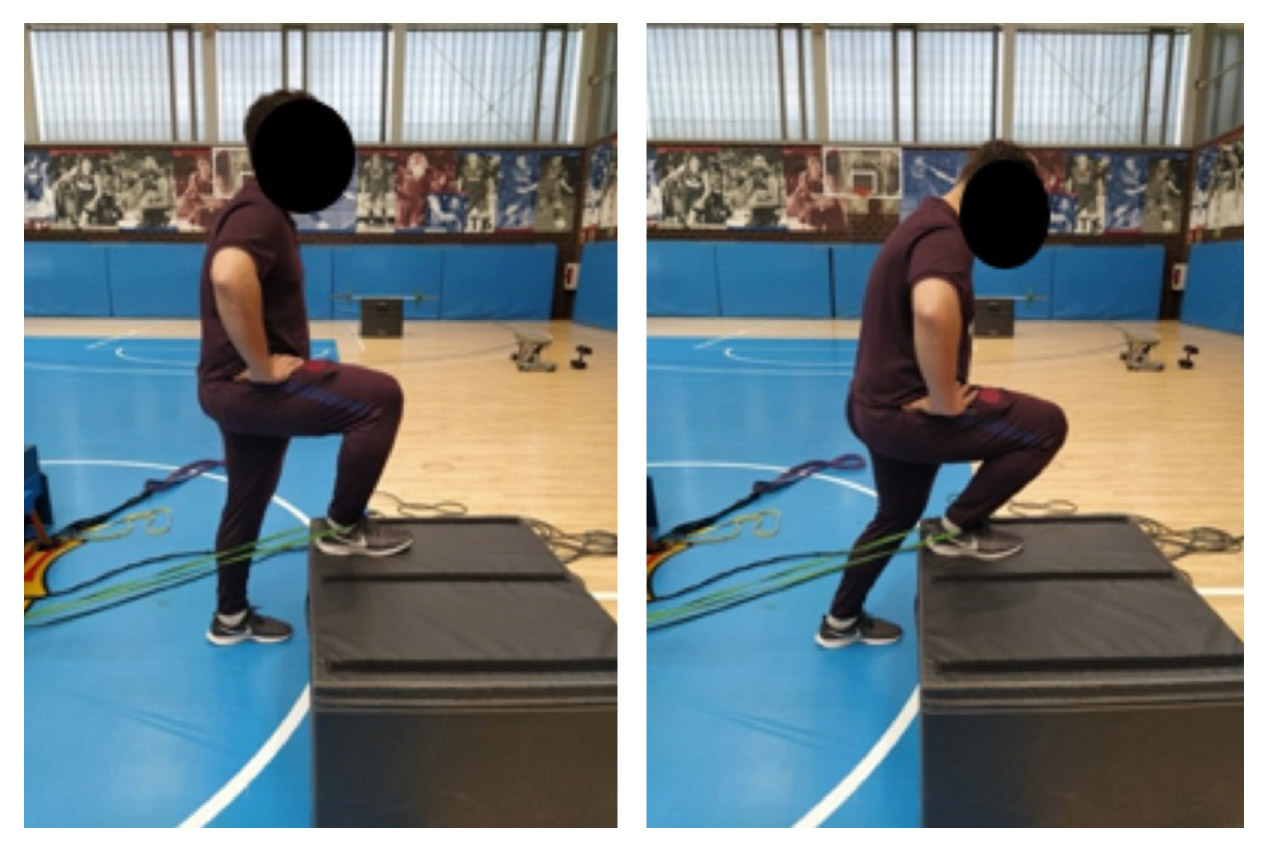
Working the peroneal muscles in CKC (Figure 2) and the tibialis posterior (Figure 3)
Place two platforms between 3 and 5 cm high on the floor. From the standing position, the player places each foot on one surface so that one half of the foot is in contact with the surface and the other half is not. From this position, the player touches the floor with the side of the foot that is free or not in contact with the surface (eccentric contraction). This is followed by a movement to return to the initial position (concentric contraction). This exercise focuses on the peroneus muscle (Figure 2). Same exercise idea is realized for posterior tibialis but placing the other half part of foot on platform and performing counter movement (Figure 3). Two sets of between 6 and 8 repetitions should be performed.
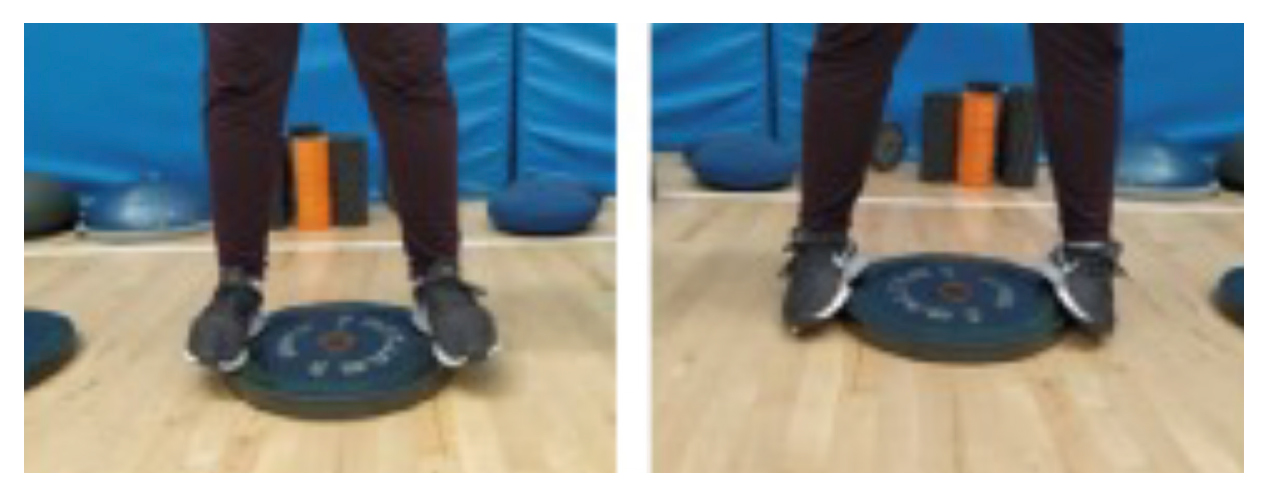
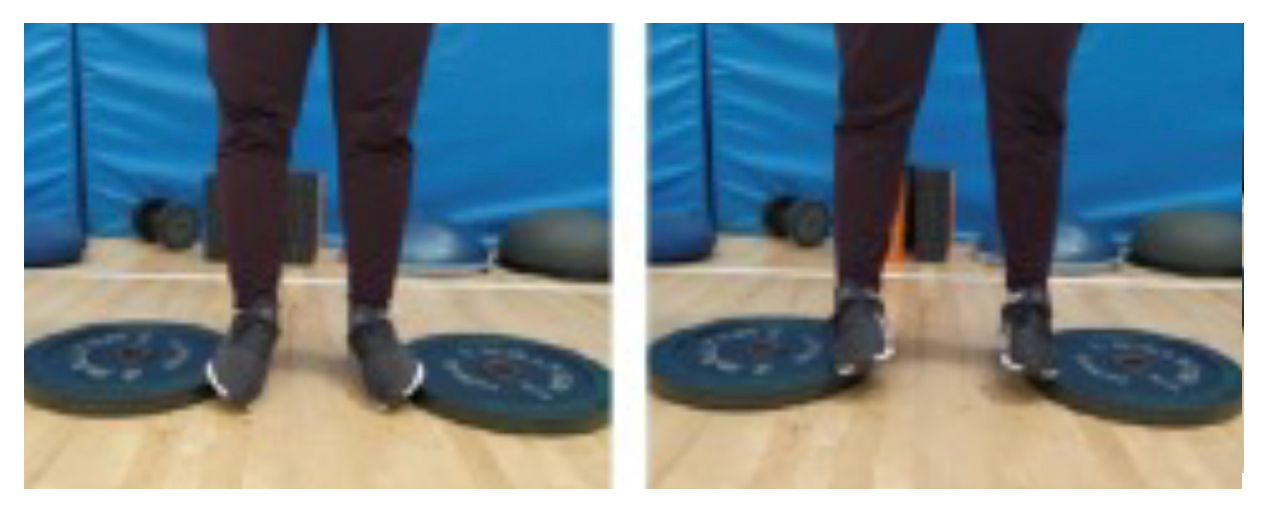
Working plantar flexion in CKC with one-leg flexion of the knee on an Airex (Figure 4)
The player places one leg on an Airex. From this position, the player performs a (concentric) plantar flexion and an (eccentric) dorsiflexion in the full range of motion. The knee should be bent to between 30º and 70°. The player should use their hands to stabilize themselves if necessary. Two sets of between 6 and 8 repetitions should be performed.
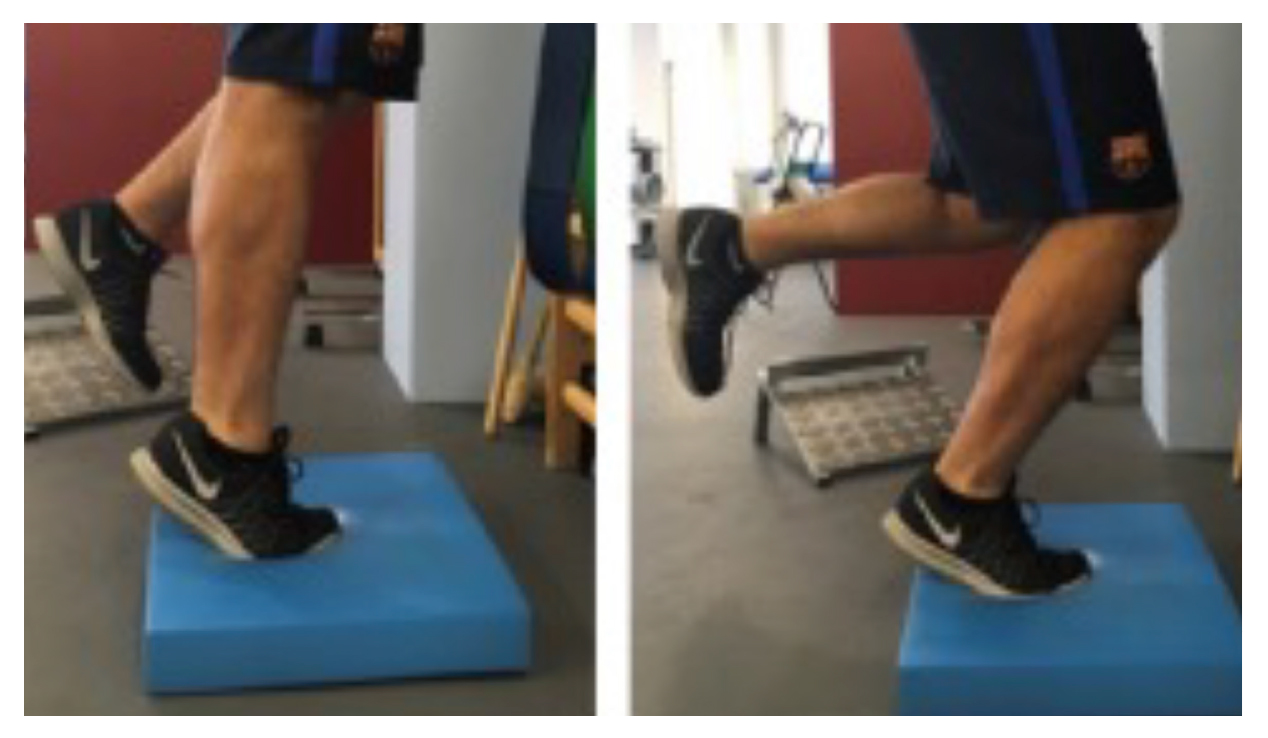
Single-foot active functional exercise 1 (Figure 5)
The player takes up position on one foot on an unstable platform with degrees of hip and knee flexion that allow them to attain a comfortable and stable position. From this position, the objective is to reach a static single-leg balance position on the Pielaster. Once this has been achieved, the next objective is to perform rotations with a soft medicine ball following diagonal patterns in different combinations. Two sets of between 6 and 8 repetitions should be performed. The repetitions will always be different, no more than 2-3 consecutive repetitions performing the same diagonal.
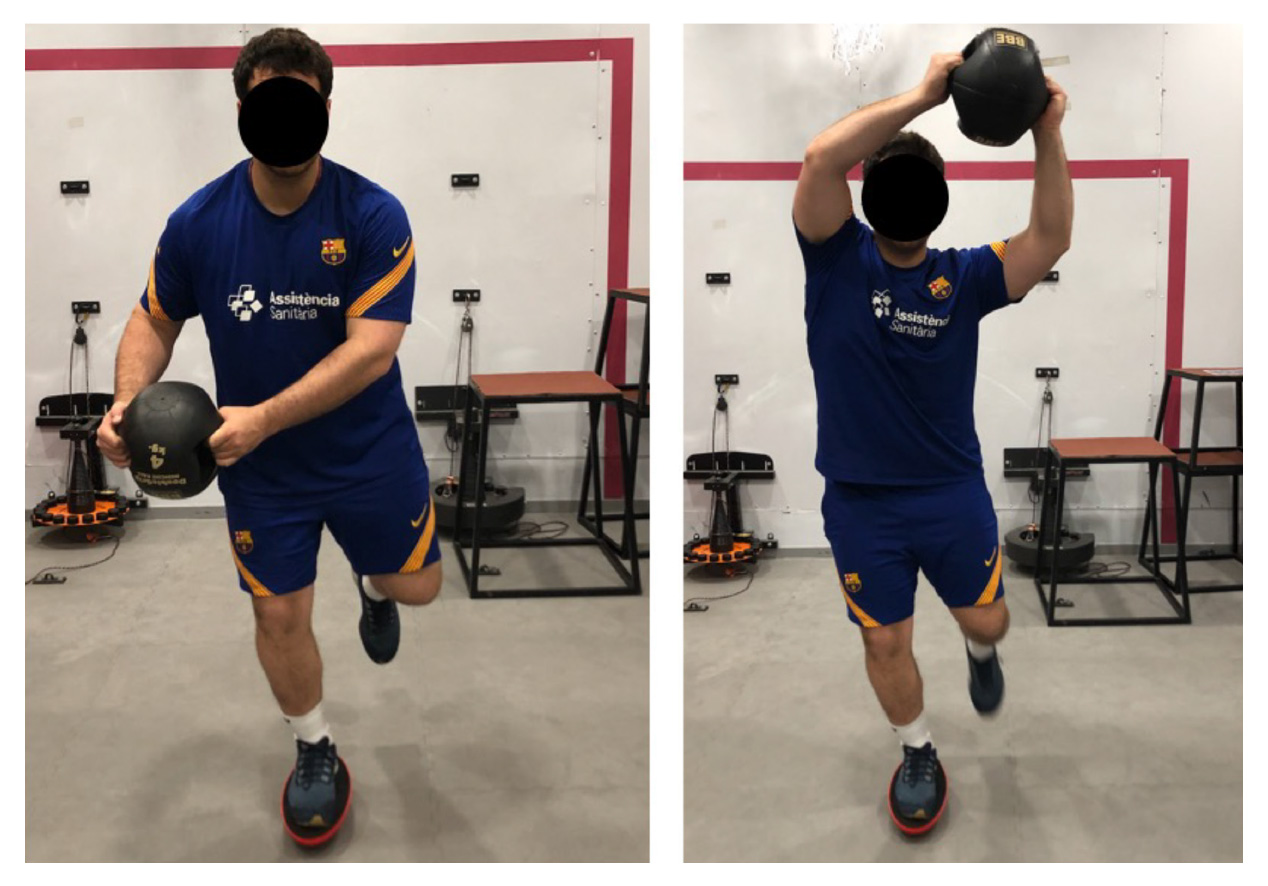
Single-foot active functional exercise 2 (Figure 6)
The player takes up position with one foot on a Pielaster-platform with degrees of ankle, knee and hip flexion that provide a comfortable position to perform an exercise while remaining stable. From this position, the first objective is to reach a static balance position. Once this has been achieved, the next goal will be to perform a hip and upper body flexion of up to 90 degrees with the other leg raised in extension. Players can place Mini Band-type elastic bands between their knees to increase exercise difficulty. Two sets of between 6 and 8 repetitions should be performed.
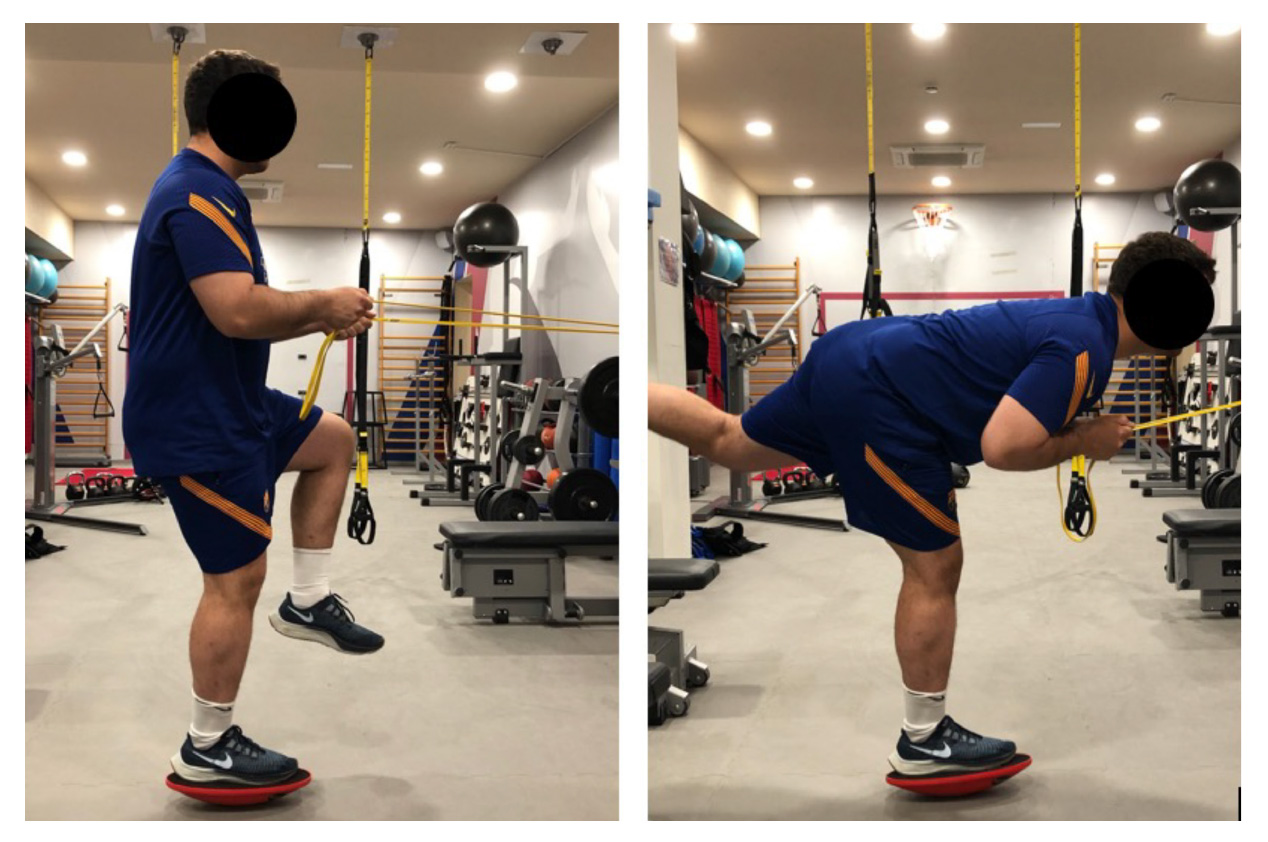
Lateral movement exercise (Figure 7)
From the standing position, the player attaches an elastic band to their hip and secures it to a stable surface that allows them to generate tension. The player should take up a position so that when they perform a lateral movement in one direction the elastic band will pull in the opposite direction. The exercise has to be performed taking two lateral steps at high speed. Two sets of between 6 and 8 repetitions should be performed. The repetitions should not always be performed in the same direction on one plane, but should be executed in different directions.
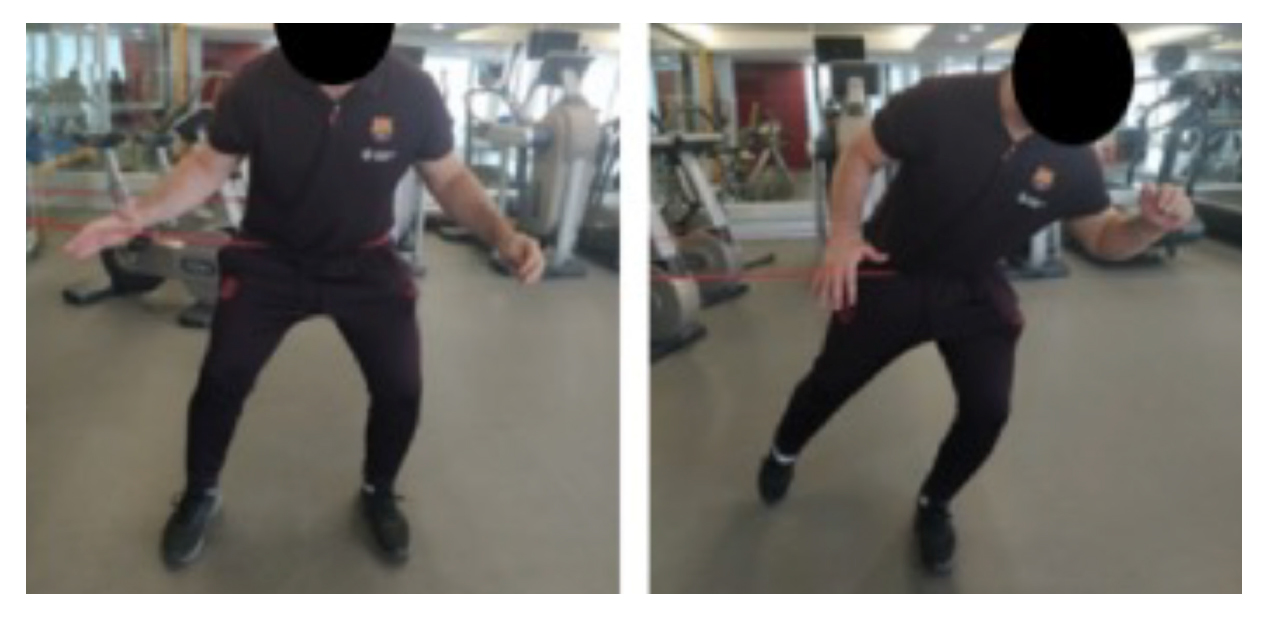
Footwork with competitive movement (Figure 8)
This exercise seeks to simulate “coordination ladders” by placing marks and using the lines of the field of play or court. Two players take up position, one on each side, ready to perform the same exercise identically, 4.9 m away from each other. From this position, they perform the footwork as quickly as possible and then run as speedily as possible to a 1.5 m-space marked out on the free-throw line. Each player should perform 2 sets of 3 repetitions. This work should always be done in pairs, it is a competitive exercise.
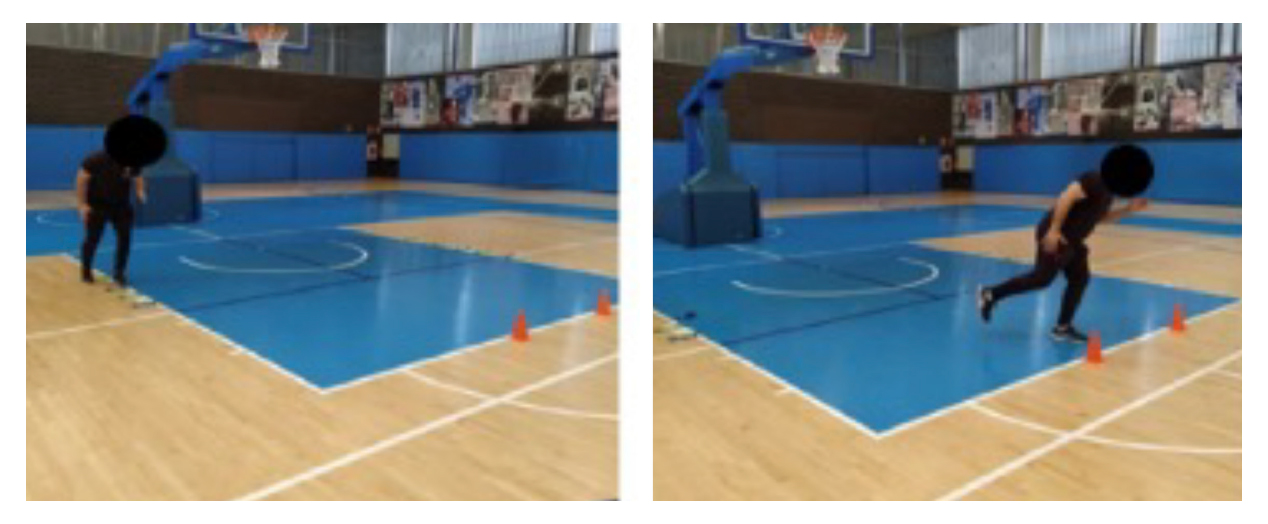
Conclusions
This proposal provides an example of ankle joint neuromuscular exercises to be performed during pre-basketball practice warm-up. The main practical application for physiotherapists and strength conditioning professional is to show examples of exercises and how to organise this idea during a competitive week in an elite professional basketball schedule. Moreover, this idea would help medical staff to improve their injury prevention strategies.
References
[1] Backman, L. J., & Danielson, P. (2011). Low range of ankle dorsiflexion predisposes for patellar tendinopathy in junior elite basketball players: a 1-year prospective study. The American Journal of Sports Medicine, 39(12), 2626–2633. https://doi.org/10.1177/0363546511420552
[2] Borowski, L. A., Yard, E. E., Fields, S. K., & Comstock, R. D. (2008). The epidemiology of US high school basketball injuries, 2005-2007. The American Journal of Sports Medicine, 36(12), 2328–2335. https://doi.org/10.1177/0363546508322893
[3] Caldemeyer, L. E., Brown, S. M., & Mulcahey, M. K. (2020). Neuromuscular Training for the Prevention of Ankle Sprains in Female Athletes: A Systematic Review. The Physician and Sportsmedicine 48(4), 363–369. https://doi.org/10.1080/00913847.2020.1732246
[4] Eils, E., Schroter, R., Schroder, M., Gerss, J., & Rosenbaum, D. (2010). Multistation proprioceptive exercise program prevents ankle injuries in basketball. Medicine and Science in Sports and Exercise, 42(11), 2098–2105. https://doi.org/10.1249/MSS.0b013e3181e03667
[5] Gabbe, B. J., Finch, C. F., Wajswelner, H., & Bennell, K. L. (2004). Predictors of lower extremity injuries at the community level of Australian football. Clinical Journal of Sport Medicine: Official Journal of the Canadian Academy of Sport Medicine, 14(2), 56–63. https://doi.org/10.1097/00042752-200403000-00002
[6] Lentell, G., Katzman, L. L., & Walters, M. R. (1990). The Relationship between Muscle Function and Ankle Stability. The Journal of Orthopaedic and Sports Physical Therapy, 11(12), 605–611. https://doi.org/10.2519/jospt.1990.11.12.605
[7] Ostojic, S., Mazic, S. &, Dikic, N. (2006). Profiling in basketball: physical and physiological characteristics of elite players. Journal of Strenght and conditioning Research, 20(4), 740–744. https://doi.org/10.1519/R-15944.1
[8] Owoeye, O. B. A., Palacios-Derflingher, L. M., & Emery, C. A. (2018). Prevention of Ankle Sprain Injuries in Youth Soccer and Basketball. Clinical Journal of Sport Medicine, 28(4), 325–331. https://doi.org/10.1097/JSM.0000000000000462
[9] Padua, E., Grazia, A., Alashram, A., Campoli, F., Romagnoli, C., Lombardo, M., Quarantelli, M., Di Pinti, E., Tonanzi, C., & Annino, G. (2019). Effectiveness of warm-up routine on the ankle injuries prevention in young female basketball players: A randomized controlled trial. Medicina, 55(10), 690. MDPI AG. Retrieved from dx.doi.org/10.3390/medicina55100690
[10] Pasanen, K., Ekola, T., Vasankari, T., Kannus, P., Heinonen, A., Kujala, U. M., & Parkkari, J. (2017). High ankle injury rate in adolescent basketball: A 3-year prospective follow-up study. Scandinavian Journal of Medicine & Science in Sports, 27(6), 643–649. https://doi.org/10.1111/sms.12818
[11] Pau, M., Loi, A., & Pezzotta, M. C. (2012). Does sensorimotor training improve the static balance of young volleyball players? Sports Biomechanics, 11(1), 97–107. https://doi.org/10.1080/14763141.2011.637126
[12] Plisky, P. J., Rauh, M. J., Kaminski, T. W., & Underwood, F. B. (2006). Star Excursion Balance Test as a predictor of lower extremity injury in high school basketball players. The Journal of Orthopaedic and Sports Physical Therapy, 36(12), 911–919. https://doi.org/10.2519/jospt.2006.2244
[13] Pope, R., Herbert, R., & Kirwan, J. (1998). Effects of ankle dorsiflexion range and pre-exercise calf muscle stretching on injury risk in Army recruits. The Australian Journal of Physiotherapy, 44(3), 165–172. https://doi.org/10.1016/s0004-9514(14)60376-7
[14] Riva, D., Bianchi, R., Rocca, F., & Mamo, C. (2016). Proprioceptive Training and Injury Prevention in a Professional Men’s Basketball Team: A Six-Year Prospective Study. Journal of Strength and Conditioning Research, 30(2), 461–475. https://doi.org/10.1519/JSC.0000000000001097
[15] Rodas, G., Bove, T., Caparrós, T., Langohr, K., Medina, D., Hamilton, B., Sugimoto, D. & Casals, M. (2019). Ankle Sprain Versus Muscle Strain Injury in Professional Men’s Basketball: A 9-Year Prospective Follow-up Study. Orthop. J. Sport. Med. 7(6). https://doi.org/10.1177/2325967119849035
[16] Sánchez Ballesta, A., Abruñedo, J., & Caparrós, T. (2019). Accelerometry in Basketball. Study of External Load during Training. Apunts Educación Física y Deportes, 135, 100-117. doi.org/10.5672/apunts.2014-0983.es.(2019/1).135.07
[17] Scanlan, A., Dascombe, B. &, Reabur, P. A comparison of the activity demands of elite and sub-elite Australian men’s basketball competition. (2011). Journal of Sports Science. 29(11), 1153–1160. https://doi.org/10.1080/02640414.2011.582509
[18] Starkey, C. (2000). Injuries and illnesses in the national basketball association: a 10-year perspective. Journal of Athletic Training, 35(2), 161–167. https://doi.org/10.1177/1941738109357303
[19] Steib, S., Zahn, P., Zu Eulenburg, C., Pfeifer, K., & Zech, A. (2016). Time-dependent postural control adaptations following a neuromuscular warm-up in female handball players: a randomized controlled trial. BMC Sports Science, Medicine & Rehabilitation, 13, 8–33. https://doi.org/10.1186/s13102-016-0058-5
[20] Stojanovic, E., Stojiljkovic, N., Scanlan, A. T., Dalbo, V. J., Berkelmans, D. M., & Milanovic, Z. (2018). The Activity Demands and Physiological Responses Encountered During Basketball Match-Play: A Systematic Review. Sports Medicine (Auckland, N.Z.), 48(1), 111–135. https://doi.org/10.1007/s40279-017-0794-z
[21] Vázquez-Guerrero, J., Fernández-Valdés, B., Jones, B., Moras, G., Reche, X., & Sampaio, J. (2019a). Changes in physical demands between game quarters of U18 elite official basketball games. PLOS ONE, 14, 1–9, e0221818. Retrieved from https://doi.org/10.1371/journal.pone.0221818
[22] Vázquez-Guerrero, J., Jones, B., Fernández-Valdés, B., Moras, G., Reche, X., & Sampaio, J. (2019b). Physical demands of elite basketball during an official U18 international tournament. Journal of Sports Sciences, 37(22), 2530–2537. https://doi.org/10.1080/02640414.2019.1647033
[23] Yeung, M. S., Chan, K. M., So, C. H., & Yuan, W. Y. (1994). An epidemiological survey on ankle sprain. British Journal of Sports Medicine, 28(2), 112–116. https://doi.org/10.1136/bjsm.28.2.112
ISSN: 2014-0983
Received: 26 de noviembre de 2020
Accepted: 8 de abril de 2021
Published: 1 de julio de 2021
Editor: © Generalitat de Catalunya Departament de la Presidència Institut Nacional d’Educació Física de Catalunya (INEFC)
© Copyright Generalitat de Catalunya (INEFC). This article is available from url https://www.revista-apunts.com/. This work is licensed under a Creative Commons Attribution-NonCommercial-NoDerivatives 4.0 International License. The images or other third party material in this article are included in the article’s Creative Commons license, unless indicated otherwise in the credit line; if the material is not included under the Creative Commons license, users will need to obtain permission from the license holder to reproduce the material. To view a copy of this license, visit https://creativecommons.org/licenses/by-nc-nd/4.0/deed.en


